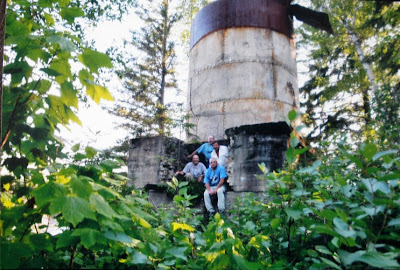
As you fish along the shores and islands at the west end of Red Lake there is barely a trace any more of the hubbub of the 1926 Gold Rush, except for the old lime kiln on the side of Hall Bay.
Bow Narrows' angler Paul Stowick supplied this photo of his group at the kiln. Hey, who's taking the picture? Maybe the camera was on a tripod and the timer activated.
Made of concrete, fire brick and steel, the lime kiln stands like an old tombstone, no clue as to its origin, purpose or death.
It actually was in operation in 1948; so, it was one of the last parts of the west-end gold rush to operate. By that date all of the gold mines at the very west end of the lake such as May-Spires, Cole, West Red Lake and Miles, had ceased, to my knowledge. Several of them had burned down in a forest fire in the late '30s.
There were two gold mines that were accessed from Golden Arm still going then, but just barely. They were the Lake Rowan and Red Crest mines.
The real paydirt had been hit at the east end of the lake, where the town of Red Lake is now located. Just about everybody had pulled up stakes and moved there.
The lime kiln; however, was just being built in the late '40s. The mines at the east end of the lake such as the famous Howey Mine which was located between where Sobeys and the Legion are now needed lime for their operations. As far as I know, it was just for making concrete, not for the gold-milling process.
At Hall Bay, limestone would have been hauled to the kiln from a nearby pit, roasted, presumably using firewood as fuel, and the lime collected.
I have a newspaper article from 1948 stating that lime from the kiln had just been analyzed and was determined to be of good quality. There is no word about the kiln operation after that.
But something spectacular happened in 1948 that changed everything for Red Lake. A road was built to it. Up until that point everything had to come by water transportation from Hudson, near Sioux Lookout which was the closest rail terminus but was more than 100 miles away.
The fact the lime kiln faded into oblivion after that year would indicate that lime was simply hauled up the road by truck, probably a cheaper alternative to the Hall Bay operation and the water transportation needed to get the finished lime to town.
Another important thing happened in 1948, at least as far as we are concerned. Bow Narrows Camp was built!
Bill Stupack, one of the gold rush pioneers, a trapper, prospector and market hunter for the mines, could see that sport hunters and fishermen were likely to come to Red Lake with the creation of the road. He built four small cabins for them at the present location of Bow Narrows Camp.
A friend and fellow pioneer, Art Carlson, who had also supplied wild meat to the mines before the road was made and who as a carpenter and log-building maker had helped build many of the buildings for the mines and their workers, did the same thing on Douglas Lake which is the lake that feeds the stream at the end of Trout Bay. He called his camp Viking Island Lodge.
Click to go back to our website
Click to see the latest on the blog


1 comment:
Nice article Dan. It's good to learn a little bit of history of the Red Lake region. Thanks!!
Dave M.
Post a Comment